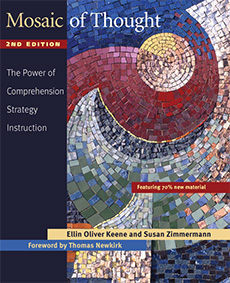For my Elementary Literacy Methods class at Longwood I was able to pick from a selection of textbooks that revolved around comprehension, vocabulary, and writing. Our professor suggested that we select a textbook that seems appropriate for our grade level or sparks an interest for us.

For my writing textbook I chose 51 Wack We-search Reports. I thought that this textbook was the best out of the three that I selected and what’s even better is that it tied into my research question! Inside are 51 ways you can get students to write, interactive projects, create visuals, and so much more! The whole point of the book is to make learning fun and give students new ideas on how to think about content. What I like the best about this book is that it crosses subjects. This book isn’t just about writing and how to write, it’s about connecting content from other subjects and tying it to writing. The book is teacher friendly and easy to read. It gives you instructions on how to get your students attention, tell jokes, and connect learning. I have inserted a picture of a lesson that connects history to writing. I also took a really important memo from this book, and that is sometimes when students get to pick topics or have the choice on assignments they’ll make them funny.

For vocabulary I picked the book Vocabulary Unplugged a book that has 30 lessons for students k-12. This textbook is very similar to the textbook above in the way that it’s set up. On each page it tells you fun and engaging activities that you can do with your students, the further you flip through the book the more sophisticated the activities get! The activities seem to be really fun, one of my favorite activities that I wish I would have done wit my sixth graders is a scavenger hunt. In the sixth grade we’ve been going over figurative language, prefixes, and suffixes. The scavenger hunt has the students go around the classroom and find specific vocabulary. I have attached a picture of the page where this scavenger hunt is described. A memo that I took from this book was that everyday objects can turn into the best learning tools and this book has tons of examples!

Mosaic of Thought was the book I chose for my comprehension textbook. If I’m going to be honest, it wasn’t my favorite. I think it was less teacher friendly than all the other textbooks I chose and it wasn’t ass organized and captivating. However, there is some great information in this book and I found it helpful for me to look at. There aren’t lessons or activities in this textbook it’s more informational. The book talks about why teaching comprehension is so important and how to implement strategies long term in your classroom. Comprehension is a skill that the student I tutored lacked and this book showed me a technique that I used with her and she seemed to really enjoy it, it was called monitoring read. This is when students read a sentence and can tell if it makes sense or not. If you have good comprehension strategies and pay attention to what you read then when a sentence doesn’t make sense then you’d stop and take a second look. I did this with my tutoring student and gave her a passage that made no sense and I asked her to read it. Since her comprehension isn’t the best she couldn’t tell anything was wrong with it, but when I read it to her she laughed at me. We focused on paying attention to what we read that day and learned to make mental pictures and when our pictures seem weird then maybe the sentence doesn’t make sense. The memo I took from this was that comprehension is the backbone of literacy, without it there is very little that you can do with reading and writing, this is why we introduce it at such an early age.
Citations
Keene, E. O., & Zimmermann, S. (2007). Mosaic of thought: the power of comprehension strategy instruction. Portsmouth: Heinemann.
Morris, A. (2006). Vocabulary unplugged. Shoreham, Vt.: Discover Writing Press.
Lane, B., & Bodimeade, M. (2003). 51 Wacky We-Search Reports: Face the Facts With Fun. VT: Discover Writing Press.